BTEC Accounting Principles: Financial Statements and Budgetary Control
VerifiedAdded on 2023/06/07
|17
|5508
|203
Report
AI Summary
This report delves into core accounting principles essential for business success, emphasizing recording, classifying, summarizing, and interpreting financial data for internal and external stakeholders. It highlights the scope and purpose of accounting, including transaction recording, income statement preparation, balance sheet analysis, and cash flow statement construction. The report also examines ethical considerations in accounting, emphasizing independence, objectivity, integrity, confidentiality, professional competence, and behavior. Furthermore, it explores the preparation of financial statements, ratio analysis, and the creation of a 12-month cash budget, discussing the importance and limitations of budgeting and offering solutions for budgetary control. The analysis provides a comprehensive overview of accounting functions and their impact on decision-making and business performance. Desklib provides students with access to past papers and solved assignments to aid in their studies.
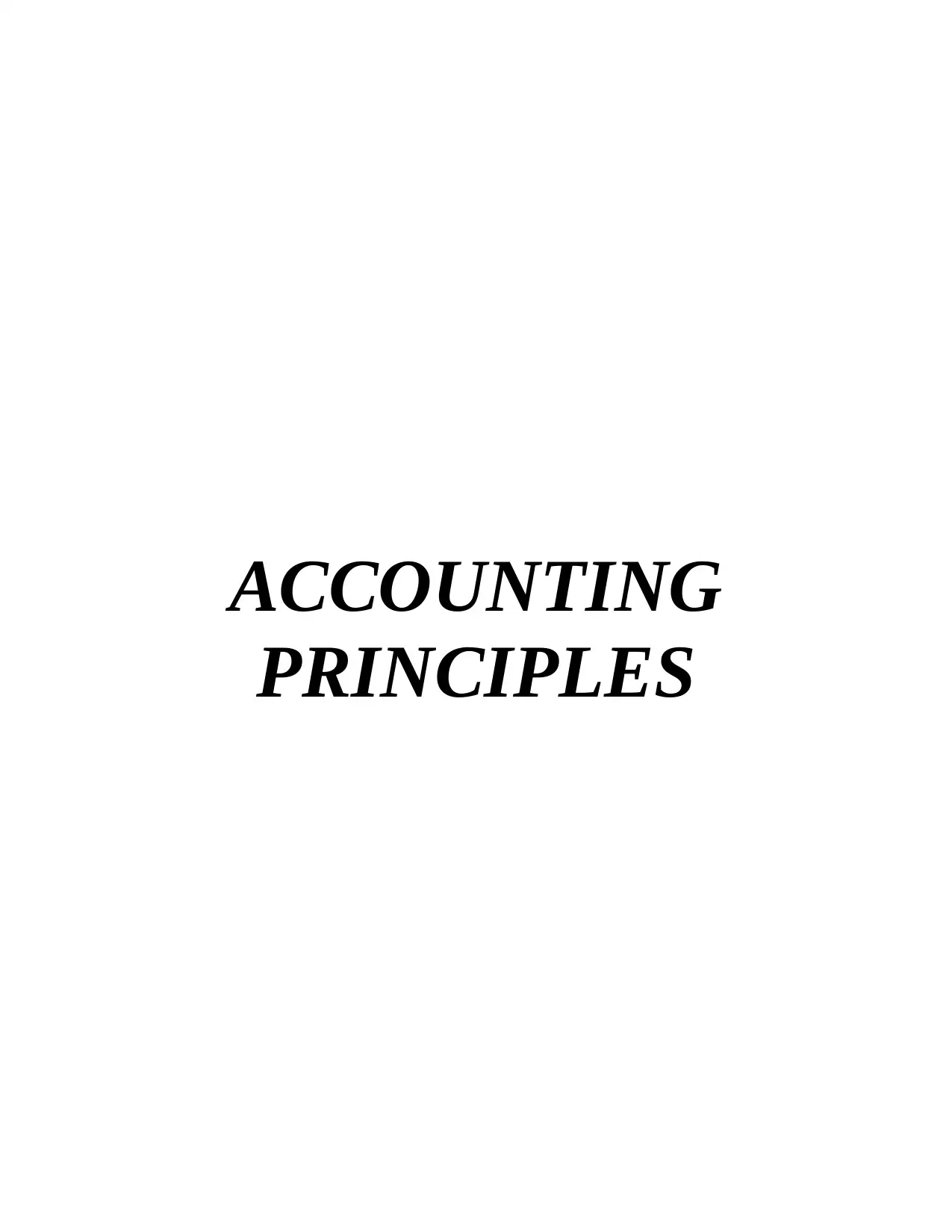
ACCOUNTING
PRINCIPLES
PRINCIPLES
Paraphrase This Document
Need a fresh take? Get an instant paraphrase of this document with our AI Paraphraser
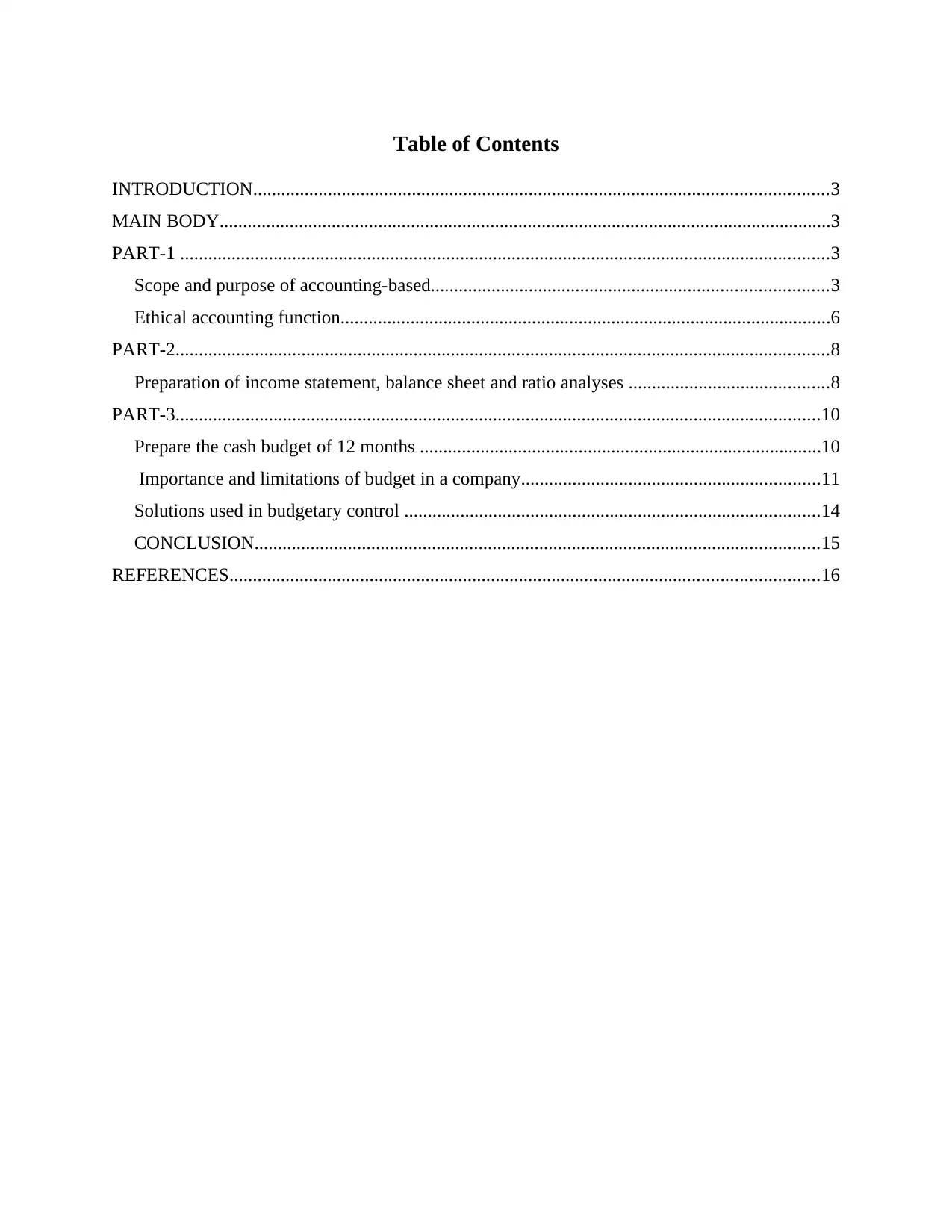
Table of Contents
INTRODUCTION...........................................................................................................................3
MAIN BODY...................................................................................................................................3
PART-1 ...........................................................................................................................................3
Scope and purpose of accounting-based.....................................................................................3
Ethical accounting function.........................................................................................................6
PART-2............................................................................................................................................8
Preparation of income statement, balance sheet and ratio analyses ...........................................8
PART-3..........................................................................................................................................10
Prepare the cash budget of 12 months ......................................................................................10
Importance and limitations of budget in a company................................................................11
Solutions used in budgetary control .........................................................................................14
CONCLUSION.........................................................................................................................15
REFERENCES..............................................................................................................................16
INTRODUCTION...........................................................................................................................3
MAIN BODY...................................................................................................................................3
PART-1 ...........................................................................................................................................3
Scope and purpose of accounting-based.....................................................................................3
Ethical accounting function.........................................................................................................6
PART-2............................................................................................................................................8
Preparation of income statement, balance sheet and ratio analyses ...........................................8
PART-3..........................................................................................................................................10
Prepare the cash budget of 12 months ......................................................................................10
Importance and limitations of budget in a company................................................................11
Solutions used in budgetary control .........................................................................................14
CONCLUSION.........................................................................................................................15
REFERENCES..............................................................................................................................16
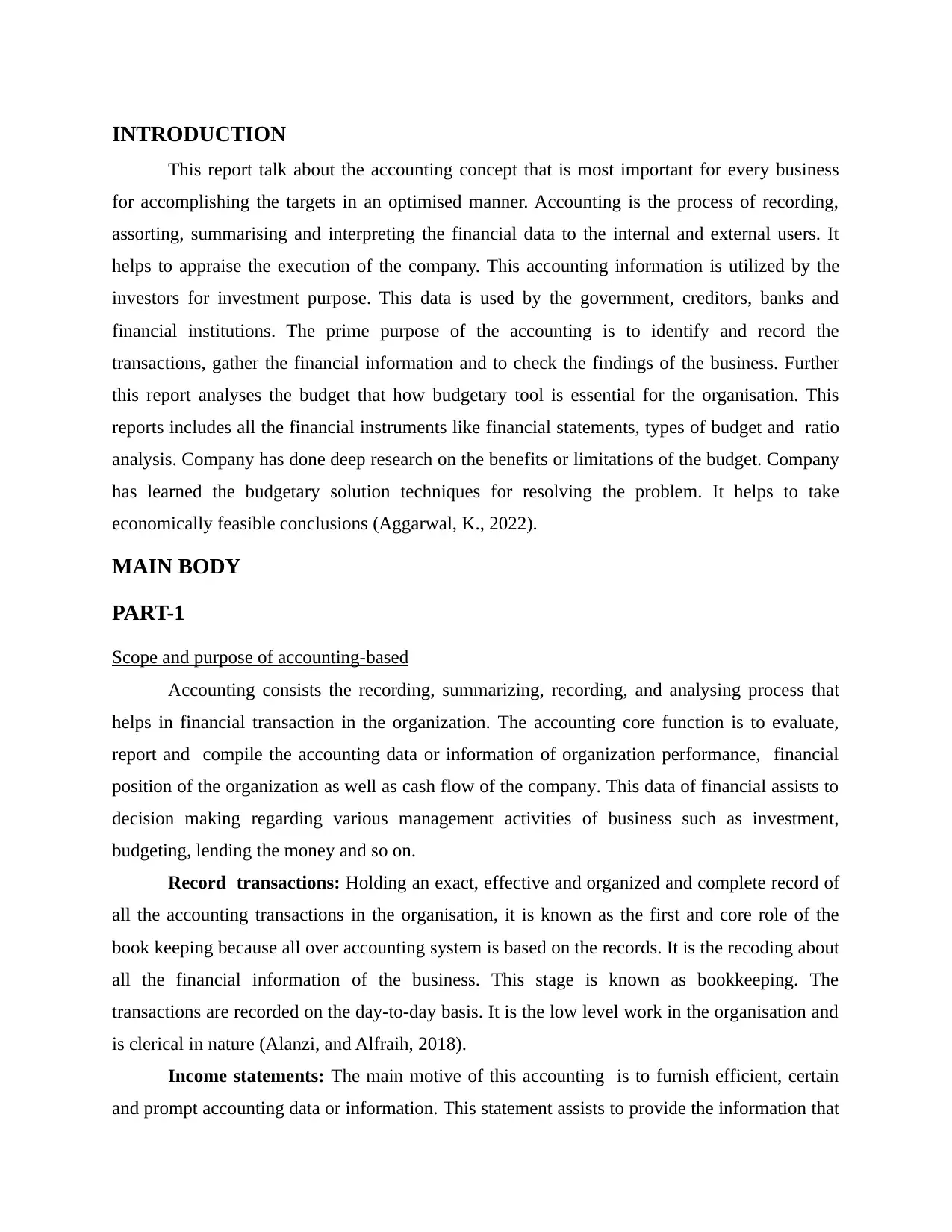
INTRODUCTION
This report talk about the accounting concept that is most important for every business
for accomplishing the targets in an optimised manner. Accounting is the process of recording,
assorting, summarising and interpreting the financial data to the internal and external users. It
helps to appraise the execution of the company. This accounting information is utilized by the
investors for investment purpose. This data is used by the government, creditors, banks and
financial institutions. The prime purpose of the accounting is to identify and record the
transactions, gather the financial information and to check the findings of the business. Further
this report analyses the budget that how budgetary tool is essential for the organisation. This
reports includes all the financial instruments like financial statements, types of budget and ratio
analysis. Company has done deep research on the benefits or limitations of the budget. Company
has learned the budgetary solution techniques for resolving the problem. It helps to take
economically feasible conclusions (Aggarwal, K., 2022).
MAIN BODY
PART-1
Scope and purpose of accounting-based
Accounting consists the recording, summarizing, recording, and analysing process that
helps in financial transaction in the organization. The accounting core function is to evaluate,
report and compile the accounting data or information of organization performance, financial
position of the organization as well as cash flow of the company. This data of financial assists to
decision making regarding various management activities of business such as investment,
budgeting, lending the money and so on.
Record transactions: Holding an exact, effective and organized and complete record of
all the accounting transactions in the organisation, it is known as the first and core role of the
book keeping because all over accounting system is based on the records. It is the recoding about
all the financial information of the business. This stage is known as bookkeeping. The
transactions are recorded on the day-to-day basis. It is the low level work in the organisation and
is clerical in nature (Alanzi, and Alfraih, 2018).
Income statements: The main motive of this accounting is to furnish efficient, certain
and prompt accounting data or information. This statement assists to provide the information that
This report talk about the accounting concept that is most important for every business
for accomplishing the targets in an optimised manner. Accounting is the process of recording,
assorting, summarising and interpreting the financial data to the internal and external users. It
helps to appraise the execution of the company. This accounting information is utilized by the
investors for investment purpose. This data is used by the government, creditors, banks and
financial institutions. The prime purpose of the accounting is to identify and record the
transactions, gather the financial information and to check the findings of the business. Further
this report analyses the budget that how budgetary tool is essential for the organisation. This
reports includes all the financial instruments like financial statements, types of budget and ratio
analysis. Company has done deep research on the benefits or limitations of the budget. Company
has learned the budgetary solution techniques for resolving the problem. It helps to take
economically feasible conclusions (Aggarwal, K., 2022).
MAIN BODY
PART-1
Scope and purpose of accounting-based
Accounting consists the recording, summarizing, recording, and analysing process that
helps in financial transaction in the organization. The accounting core function is to evaluate,
report and compile the accounting data or information of organization performance, financial
position of the organization as well as cash flow of the company. This data of financial assists to
decision making regarding various management activities of business such as investment,
budgeting, lending the money and so on.
Record transactions: Holding an exact, effective and organized and complete record of
all the accounting transactions in the organisation, it is known as the first and core role of the
book keeping because all over accounting system is based on the records. It is the recoding about
all the financial information of the business. This stage is known as bookkeeping. The
transactions are recorded on the day-to-day basis. It is the low level work in the organisation and
is clerical in nature (Alanzi, and Alfraih, 2018).
Income statements: The main motive of this accounting is to furnish efficient, certain
and prompt accounting data or information. This statement assists to provide the information that
⊘ This is a preview!⊘
Do you want full access?
Subscribe today to unlock all pages.

Trusted by 1+ million students worldwide
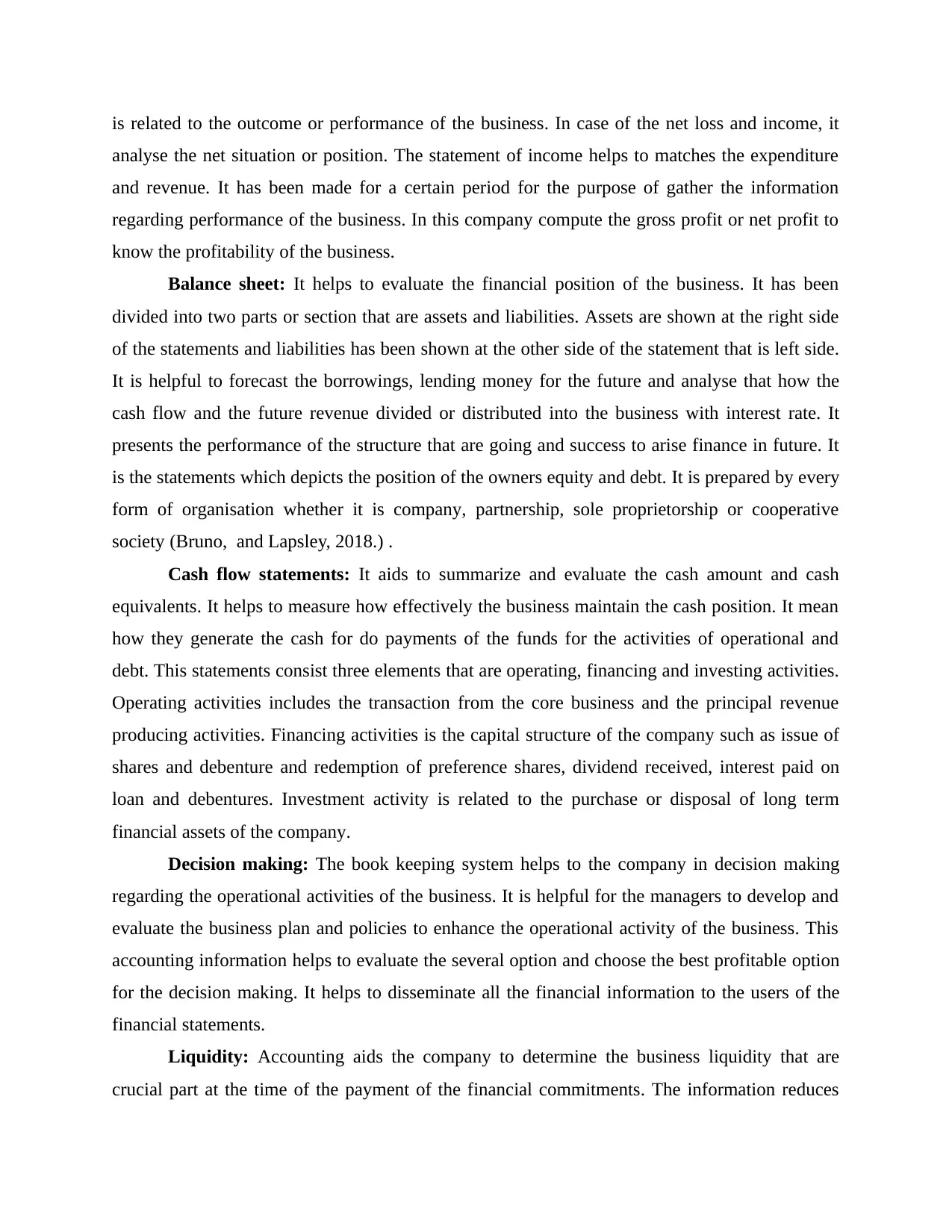
is related to the outcome or performance of the business. In case of the net loss and income, it
analyse the net situation or position. The statement of income helps to matches the expenditure
and revenue. It has been made for a certain period for the purpose of gather the information
regarding performance of the business. In this company compute the gross profit or net profit to
know the profitability of the business.
Balance sheet: It helps to evaluate the financial position of the business. It has been
divided into two parts or section that are assets and liabilities. Assets are shown at the right side
of the statements and liabilities has been shown at the other side of the statement that is left side.
It is helpful to forecast the borrowings, lending money for the future and analyse that how the
cash flow and the future revenue divided or distributed into the business with interest rate. It
presents the performance of the structure that are going and success to arise finance in future. It
is the statements which depicts the position of the owners equity and debt. It is prepared by every
form of organisation whether it is company, partnership, sole proprietorship or cooperative
society (Bruno, and Lapsley, 2018.) .
Cash flow statements: It aids to summarize and evaluate the cash amount and cash
equivalents. It helps to measure how effectively the business maintain the cash position. It mean
how they generate the cash for do payments of the funds for the activities of operational and
debt. This statements consist three elements that are operating, financing and investing activities.
Operating activities includes the transaction from the core business and the principal revenue
producing activities. Financing activities is the capital structure of the company such as issue of
shares and debenture and redemption of preference shares, dividend received, interest paid on
loan and debentures. Investment activity is related to the purchase or disposal of long term
financial assets of the company.
Decision making: The book keeping system helps to the company in decision making
regarding the operational activities of the business. It is helpful for the managers to develop and
evaluate the business plan and policies to enhance the operational activity of the business. This
accounting information helps to evaluate the several option and choose the best profitable option
for the decision making. It helps to disseminate all the financial information to the users of the
financial statements.
Liquidity: Accounting aids the company to determine the business liquidity that are
crucial part at the time of the payment of the financial commitments. The information reduces
analyse the net situation or position. The statement of income helps to matches the expenditure
and revenue. It has been made for a certain period for the purpose of gather the information
regarding performance of the business. In this company compute the gross profit or net profit to
know the profitability of the business.
Balance sheet: It helps to evaluate the financial position of the business. It has been
divided into two parts or section that are assets and liabilities. Assets are shown at the right side
of the statements and liabilities has been shown at the other side of the statement that is left side.
It is helpful to forecast the borrowings, lending money for the future and analyse that how the
cash flow and the future revenue divided or distributed into the business with interest rate. It
presents the performance of the structure that are going and success to arise finance in future. It
is the statements which depicts the position of the owners equity and debt. It is prepared by every
form of organisation whether it is company, partnership, sole proprietorship or cooperative
society (Bruno, and Lapsley, 2018.) .
Cash flow statements: It aids to summarize and evaluate the cash amount and cash
equivalents. It helps to measure how effectively the business maintain the cash position. It mean
how they generate the cash for do payments of the funds for the activities of operational and
debt. This statements consist three elements that are operating, financing and investing activities.
Operating activities includes the transaction from the core business and the principal revenue
producing activities. Financing activities is the capital structure of the company such as issue of
shares and debenture and redemption of preference shares, dividend received, interest paid on
loan and debentures. Investment activity is related to the purchase or disposal of long term
financial assets of the company.
Decision making: The book keeping system helps to the company in decision making
regarding the operational activities of the business. It is helpful for the managers to develop and
evaluate the business plan and policies to enhance the operational activity of the business. This
accounting information helps to evaluate the several option and choose the best profitable option
for the decision making. It helps to disseminate all the financial information to the users of the
financial statements.
Liquidity: Accounting aids the company to determine the business liquidity that are
crucial part at the time of the payment of the financial commitments. The information reduces
Paraphrase This Document
Need a fresh take? Get an instant paraphrase of this document with our AI Paraphraser
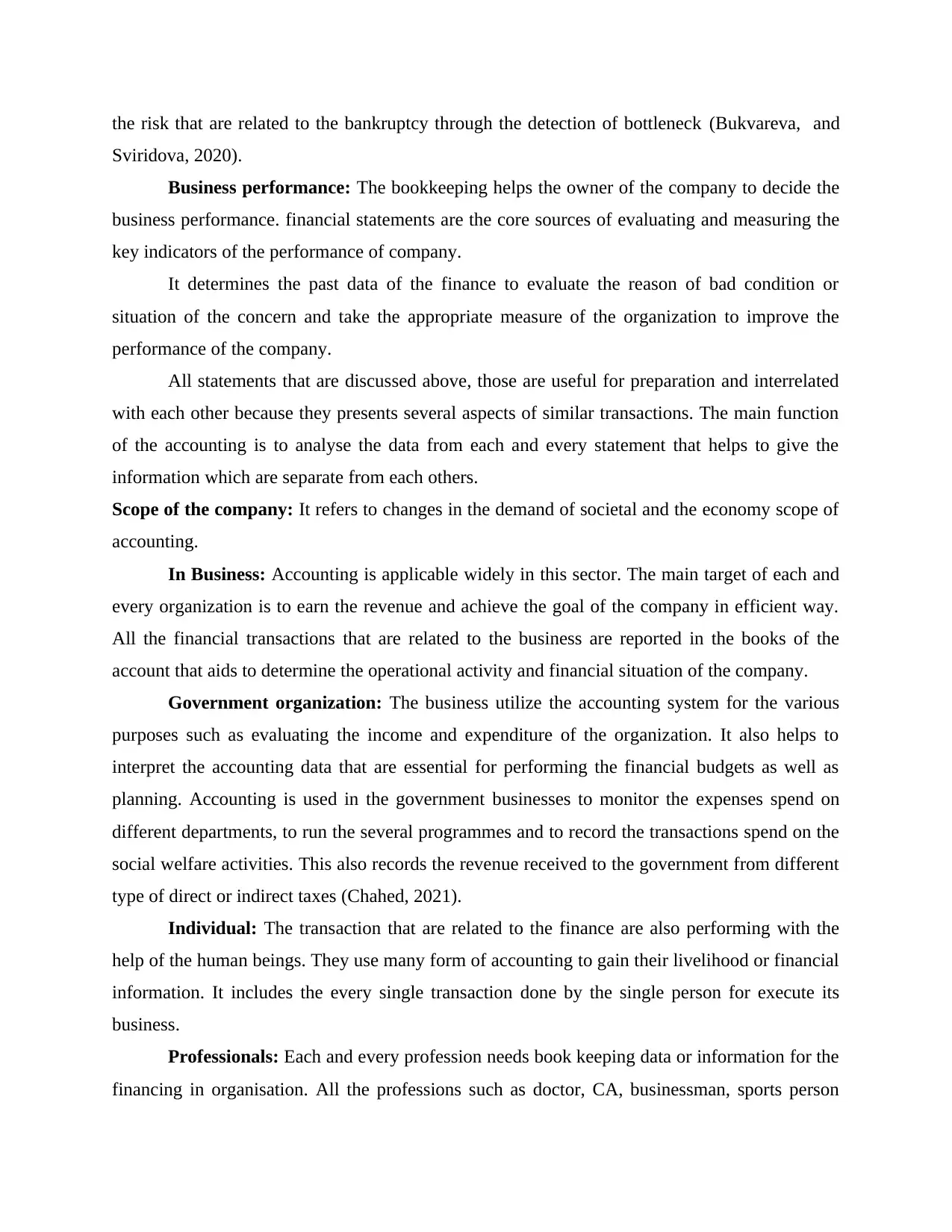
the risk that are related to the bankruptcy through the detection of bottleneck (Bukvareva, and
Sviridova, 2020).
Business performance: The bookkeeping helps the owner of the company to decide the
business performance. financial statements are the core sources of evaluating and measuring the
key indicators of the performance of company.
It determines the past data of the finance to evaluate the reason of bad condition or
situation of the concern and take the appropriate measure of the organization to improve the
performance of the company.
All statements that are discussed above, those are useful for preparation and interrelated
with each other because they presents several aspects of similar transactions. The main function
of the accounting is to analyse the data from each and every statement that helps to give the
information which are separate from each others.
Scope of the company: It refers to changes in the demand of societal and the economy scope of
accounting.
In Business: Accounting is applicable widely in this sector. The main target of each and
every organization is to earn the revenue and achieve the goal of the company in efficient way.
All the financial transactions that are related to the business are reported in the books of the
account that aids to determine the operational activity and financial situation of the company.
Government organization: The business utilize the accounting system for the various
purposes such as evaluating the income and expenditure of the organization. It also helps to
interpret the accounting data that are essential for performing the financial budgets as well as
planning. Accounting is used in the government businesses to monitor the expenses spend on
different departments, to run the several programmes and to record the transactions spend on the
social welfare activities. This also records the revenue received to the government from different
type of direct or indirect taxes (Chahed, 2021).
Individual: The transaction that are related to the finance are also performing with the
help of the human beings. They use many form of accounting to gain their livelihood or financial
information. It includes the every single transaction done by the single person for execute its
business.
Professionals: Each and every profession needs book keeping data or information for the
financing in organisation. All the professions such as doctor, CA, businessman, sports person
Sviridova, 2020).
Business performance: The bookkeeping helps the owner of the company to decide the
business performance. financial statements are the core sources of evaluating and measuring the
key indicators of the performance of company.
It determines the past data of the finance to evaluate the reason of bad condition or
situation of the concern and take the appropriate measure of the organization to improve the
performance of the company.
All statements that are discussed above, those are useful for preparation and interrelated
with each other because they presents several aspects of similar transactions. The main function
of the accounting is to analyse the data from each and every statement that helps to give the
information which are separate from each others.
Scope of the company: It refers to changes in the demand of societal and the economy scope of
accounting.
In Business: Accounting is applicable widely in this sector. The main target of each and
every organization is to earn the revenue and achieve the goal of the company in efficient way.
All the financial transactions that are related to the business are reported in the books of the
account that aids to determine the operational activity and financial situation of the company.
Government organization: The business utilize the accounting system for the various
purposes such as evaluating the income and expenditure of the organization. It also helps to
interpret the accounting data that are essential for performing the financial budgets as well as
planning. Accounting is used in the government businesses to monitor the expenses spend on
different departments, to run the several programmes and to record the transactions spend on the
social welfare activities. This also records the revenue received to the government from different
type of direct or indirect taxes (Chahed, 2021).
Individual: The transaction that are related to the finance are also performing with the
help of the human beings. They use many form of accounting to gain their livelihood or financial
information. It includes the every single transaction done by the single person for execute its
business.
Professionals: Each and every profession needs book keeping data or information for the
financing in organisation. All the professions such as doctor, CA, businessman, sports person
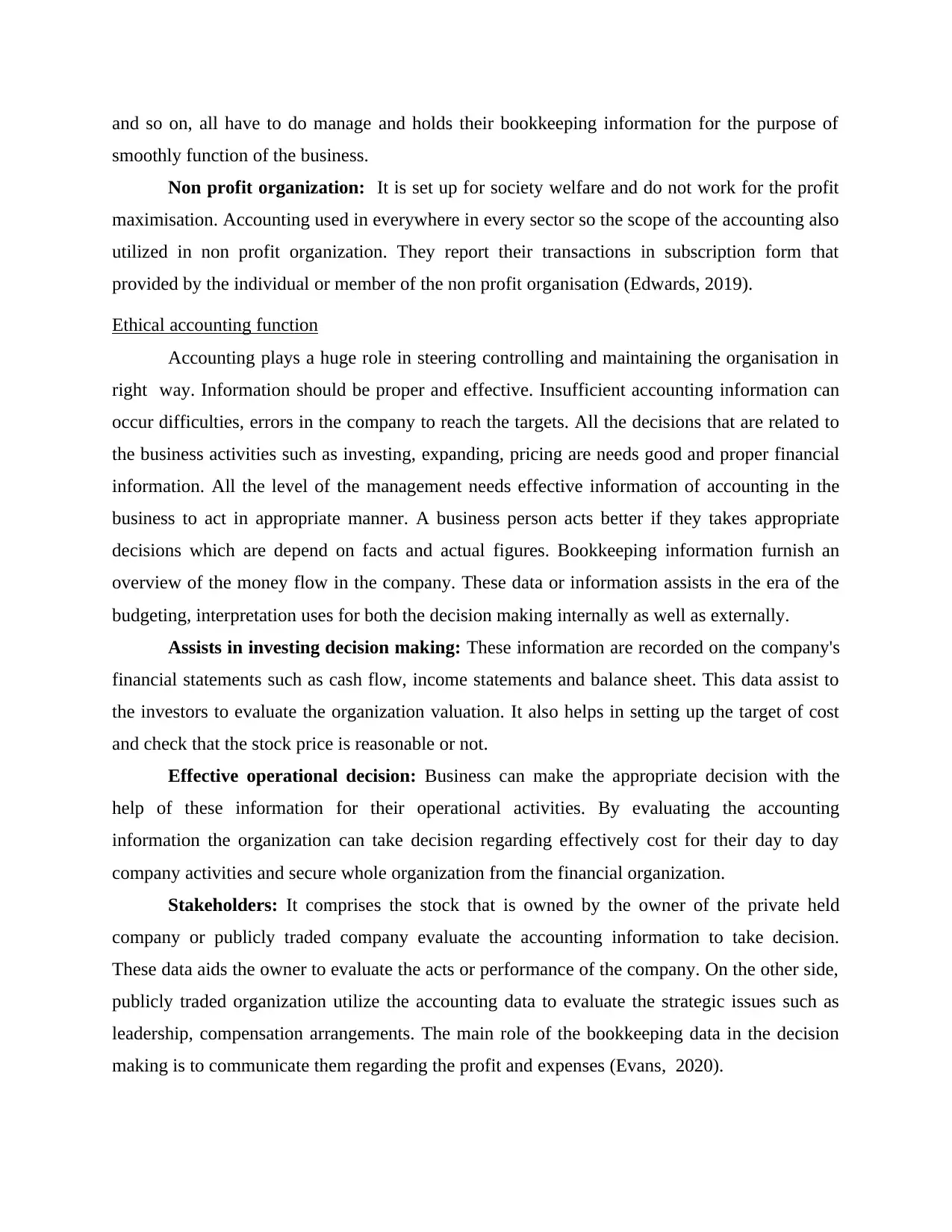
and so on, all have to do manage and holds their bookkeeping information for the purpose of
smoothly function of the business.
Non profit organization: It is set up for society welfare and do not work for the profit
maximisation. Accounting used in everywhere in every sector so the scope of the accounting also
utilized in non profit organization. They report their transactions in subscription form that
provided by the individual or member of the non profit organisation (Edwards, 2019).
Ethical accounting function
Accounting plays a huge role in steering controlling and maintaining the organisation in
right way. Information should be proper and effective. Insufficient accounting information can
occur difficulties, errors in the company to reach the targets. All the decisions that are related to
the business activities such as investing, expanding, pricing are needs good and proper financial
information. All the level of the management needs effective information of accounting in the
business to act in appropriate manner. A business person acts better if they takes appropriate
decisions which are depend on facts and actual figures. Bookkeeping information furnish an
overview of the money flow in the company. These data or information assists in the era of the
budgeting, interpretation uses for both the decision making internally as well as externally.
Assists in investing decision making: These information are recorded on the company's
financial statements such as cash flow, income statements and balance sheet. This data assist to
the investors to evaluate the organization valuation. It also helps in setting up the target of cost
and check that the stock price is reasonable or not.
Effective operational decision: Business can make the appropriate decision with the
help of these information for their operational activities. By evaluating the accounting
information the organization can take decision regarding effectively cost for their day to day
company activities and secure whole organization from the financial organization.
Stakeholders: It comprises the stock that is owned by the owner of the private held
company or publicly traded company evaluate the accounting information to take decision.
These data aids the owner to evaluate the acts or performance of the company. On the other side,
publicly traded organization utilize the accounting data to evaluate the strategic issues such as
leadership, compensation arrangements. The main role of the bookkeeping data in the decision
making is to communicate them regarding the profit and expenses (Evans, 2020).
smoothly function of the business.
Non profit organization: It is set up for society welfare and do not work for the profit
maximisation. Accounting used in everywhere in every sector so the scope of the accounting also
utilized in non profit organization. They report their transactions in subscription form that
provided by the individual or member of the non profit organisation (Edwards, 2019).
Ethical accounting function
Accounting plays a huge role in steering controlling and maintaining the organisation in
right way. Information should be proper and effective. Insufficient accounting information can
occur difficulties, errors in the company to reach the targets. All the decisions that are related to
the business activities such as investing, expanding, pricing are needs good and proper financial
information. All the level of the management needs effective information of accounting in the
business to act in appropriate manner. A business person acts better if they takes appropriate
decisions which are depend on facts and actual figures. Bookkeeping information furnish an
overview of the money flow in the company. These data or information assists in the era of the
budgeting, interpretation uses for both the decision making internally as well as externally.
Assists in investing decision making: These information are recorded on the company's
financial statements such as cash flow, income statements and balance sheet. This data assist to
the investors to evaluate the organization valuation. It also helps in setting up the target of cost
and check that the stock price is reasonable or not.
Effective operational decision: Business can make the appropriate decision with the
help of these information for their operational activities. By evaluating the accounting
information the organization can take decision regarding effectively cost for their day to day
company activities and secure whole organization from the financial organization.
Stakeholders: It comprises the stock that is owned by the owner of the private held
company or publicly traded company evaluate the accounting information to take decision.
These data aids the owner to evaluate the acts or performance of the company. On the other side,
publicly traded organization utilize the accounting data to evaluate the strategic issues such as
leadership, compensation arrangements. The main role of the bookkeeping data in the decision
making is to communicate them regarding the profit and expenses (Evans, 2020).
⊘ This is a preview!⊘
Do you want full access?
Subscribe today to unlock all pages.

Trusted by 1+ million students worldwide
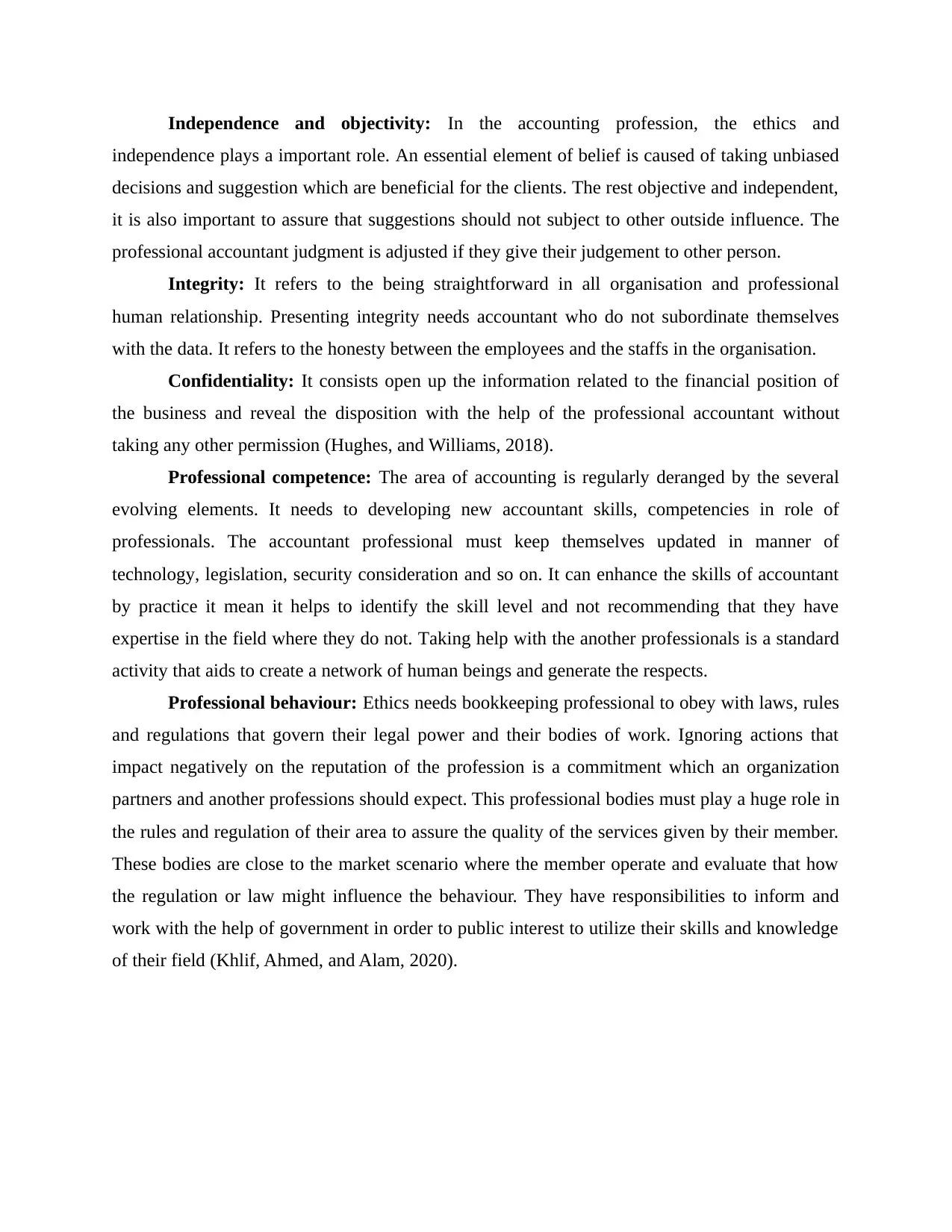
Independence and objectivity: In the accounting profession, the ethics and
independence plays a important role. An essential element of belief is caused of taking unbiased
decisions and suggestion which are beneficial for the clients. The rest objective and independent,
it is also important to assure that suggestions should not subject to other outside influence. The
professional accountant judgment is adjusted if they give their judgement to other person.
Integrity: It refers to the being straightforward in all organisation and professional
human relationship. Presenting integrity needs accountant who do not subordinate themselves
with the data. It refers to the honesty between the employees and the staffs in the organisation.
Confidentiality: It consists open up the information related to the financial position of
the business and reveal the disposition with the help of the professional accountant without
taking any other permission (Hughes, and Williams, 2018).
Professional competence: The area of accounting is regularly deranged by the several
evolving elements. It needs to developing new accountant skills, competencies in role of
professionals. The accountant professional must keep themselves updated in manner of
technology, legislation, security consideration and so on. It can enhance the skills of accountant
by practice it mean it helps to identify the skill level and not recommending that they have
expertise in the field where they do not. Taking help with the another professionals is a standard
activity that aids to create a network of human beings and generate the respects.
Professional behaviour: Ethics needs bookkeeping professional to obey with laws, rules
and regulations that govern their legal power and their bodies of work. Ignoring actions that
impact negatively on the reputation of the profession is a commitment which an organization
partners and another professions should expect. This professional bodies must play a huge role in
the rules and regulation of their area to assure the quality of the services given by their member.
These bodies are close to the market scenario where the member operate and evaluate that how
the regulation or law might influence the behaviour. They have responsibilities to inform and
work with the help of government in order to public interest to utilize their skills and knowledge
of their field (Khlif, Ahmed, and Alam, 2020).
independence plays a important role. An essential element of belief is caused of taking unbiased
decisions and suggestion which are beneficial for the clients. The rest objective and independent,
it is also important to assure that suggestions should not subject to other outside influence. The
professional accountant judgment is adjusted if they give their judgement to other person.
Integrity: It refers to the being straightforward in all organisation and professional
human relationship. Presenting integrity needs accountant who do not subordinate themselves
with the data. It refers to the honesty between the employees and the staffs in the organisation.
Confidentiality: It consists open up the information related to the financial position of
the business and reveal the disposition with the help of the professional accountant without
taking any other permission (Hughes, and Williams, 2018).
Professional competence: The area of accounting is regularly deranged by the several
evolving elements. It needs to developing new accountant skills, competencies in role of
professionals. The accountant professional must keep themselves updated in manner of
technology, legislation, security consideration and so on. It can enhance the skills of accountant
by practice it mean it helps to identify the skill level and not recommending that they have
expertise in the field where they do not. Taking help with the another professionals is a standard
activity that aids to create a network of human beings and generate the respects.
Professional behaviour: Ethics needs bookkeeping professional to obey with laws, rules
and regulations that govern their legal power and their bodies of work. Ignoring actions that
impact negatively on the reputation of the profession is a commitment which an organization
partners and another professions should expect. This professional bodies must play a huge role in
the rules and regulation of their area to assure the quality of the services given by their member.
These bodies are close to the market scenario where the member operate and evaluate that how
the regulation or law might influence the behaviour. They have responsibilities to inform and
work with the help of government in order to public interest to utilize their skills and knowledge
of their field (Khlif, Ahmed, and Alam, 2020).
Paraphrase This Document
Need a fresh take? Get an instant paraphrase of this document with our AI Paraphraser
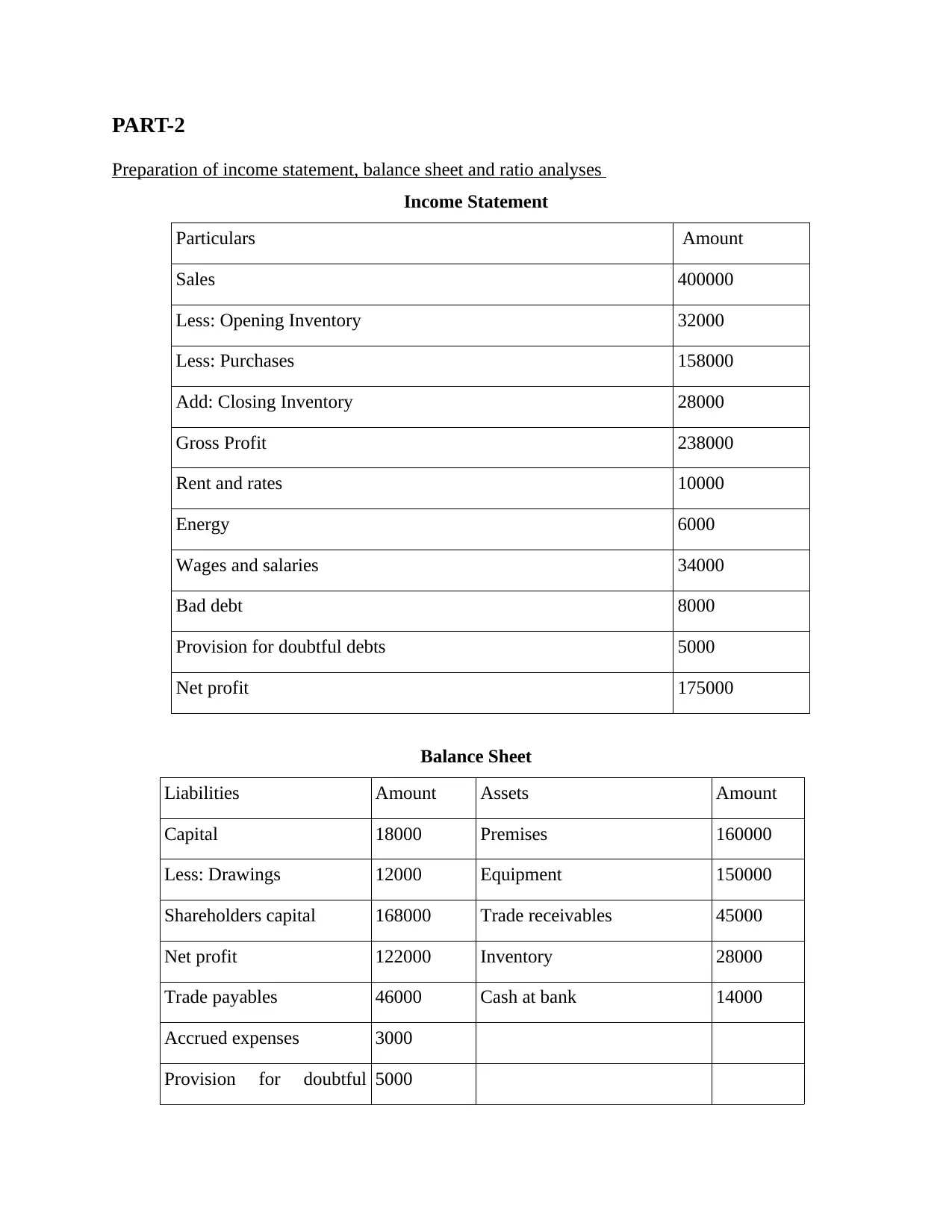
PART-2
Preparation of income statement, balance sheet and ratio analyses
Income Statement
Particulars Amount
Sales 400000
Less: Opening Inventory 32000
Less: Purchases 158000
Add: Closing Inventory 28000
Gross Profit 238000
Rent and rates 10000
Energy 6000
Wages and salaries 34000
Bad debt 8000
Provision for doubtful debts 5000
Net profit 175000
Balance Sheet
Liabilities Amount Assets Amount
Capital 18000 Premises 160000
Less: Drawings 12000 Equipment 150000
Shareholders capital 168000 Trade receivables 45000
Net profit 122000 Inventory 28000
Trade payables 46000 Cash at bank 14000
Accrued expenses 3000
Provision for doubtful 5000
Preparation of income statement, balance sheet and ratio analyses
Income Statement
Particulars Amount
Sales 400000
Less: Opening Inventory 32000
Less: Purchases 158000
Add: Closing Inventory 28000
Gross Profit 238000
Rent and rates 10000
Energy 6000
Wages and salaries 34000
Bad debt 8000
Provision for doubtful debts 5000
Net profit 175000
Balance Sheet
Liabilities Amount Assets Amount
Capital 18000 Premises 160000
Less: Drawings 12000 Equipment 150000
Shareholders capital 168000 Trade receivables 45000
Net profit 122000 Inventory 28000
Trade payables 46000 Cash at bank 14000
Accrued expenses 3000
Provision for doubtful 5000
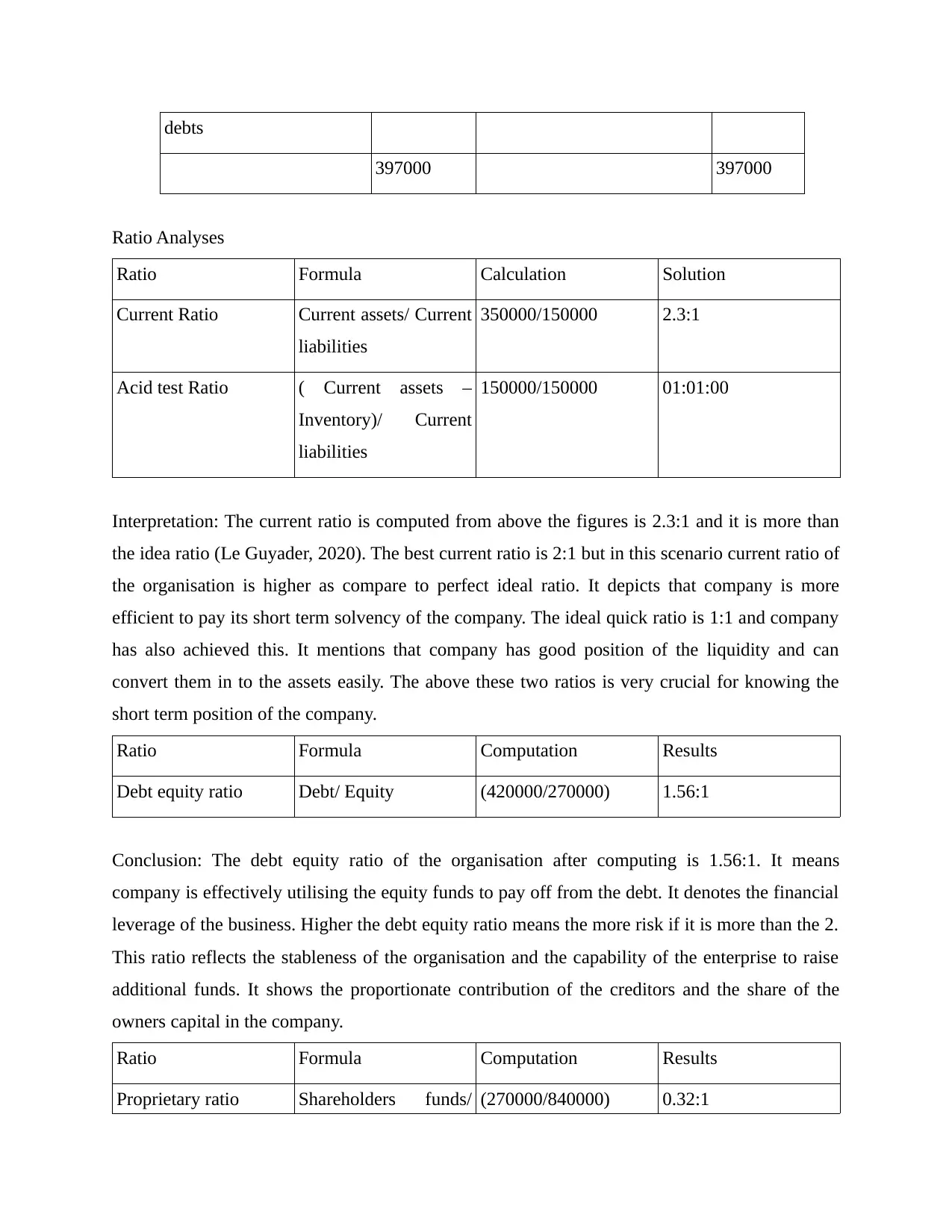
debts
397000 397000
Ratio Analyses
Ratio Formula Calculation Solution
Current Ratio Current assets/ Current
liabilities
350000/150000 2.3:1
Acid test Ratio ( Current assets –
Inventory)/ Current
liabilities
150000/150000 01:01:00
Interpretation: The current ratio is computed from above the figures is 2.3:1 and it is more than
the idea ratio (Le Guyader, 2020). The best current ratio is 2:1 but in this scenario current ratio of
the organisation is higher as compare to perfect ideal ratio. It depicts that company is more
efficient to pay its short term solvency of the company. The ideal quick ratio is 1:1 and company
has also achieved this. It mentions that company has good position of the liquidity and can
convert them in to the assets easily. The above these two ratios is very crucial for knowing the
short term position of the company.
Ratio Formula Computation Results
Debt equity ratio Debt/ Equity (420000/270000) 1.56:1
Conclusion: The debt equity ratio of the organisation after computing is 1.56:1. It means
company is effectively utilising the equity funds to pay off from the debt. It denotes the financial
leverage of the business. Higher the debt equity ratio means the more risk if it is more than the 2.
This ratio reflects the stableness of the organisation and the capability of the enterprise to raise
additional funds. It shows the proportionate contribution of the creditors and the share of the
owners capital in the company.
Ratio Formula Computation Results
Proprietary ratio Shareholders funds/ (270000/840000) 0.32:1
397000 397000
Ratio Analyses
Ratio Formula Calculation Solution
Current Ratio Current assets/ Current
liabilities
350000/150000 2.3:1
Acid test Ratio ( Current assets –
Inventory)/ Current
liabilities
150000/150000 01:01:00
Interpretation: The current ratio is computed from above the figures is 2.3:1 and it is more than
the idea ratio (Le Guyader, 2020). The best current ratio is 2:1 but in this scenario current ratio of
the organisation is higher as compare to perfect ideal ratio. It depicts that company is more
efficient to pay its short term solvency of the company. The ideal quick ratio is 1:1 and company
has also achieved this. It mentions that company has good position of the liquidity and can
convert them in to the assets easily. The above these two ratios is very crucial for knowing the
short term position of the company.
Ratio Formula Computation Results
Debt equity ratio Debt/ Equity (420000/270000) 1.56:1
Conclusion: The debt equity ratio of the organisation after computing is 1.56:1. It means
company is effectively utilising the equity funds to pay off from the debt. It denotes the financial
leverage of the business. Higher the debt equity ratio means the more risk if it is more than the 2.
This ratio reflects the stableness of the organisation and the capability of the enterprise to raise
additional funds. It shows the proportionate contribution of the creditors and the share of the
owners capital in the company.
Ratio Formula Computation Results
Proprietary ratio Shareholders funds/ (270000/840000) 0.32:1
⊘ This is a preview!⊘
Do you want full access?
Subscribe today to unlock all pages.

Trusted by 1+ million students worldwide
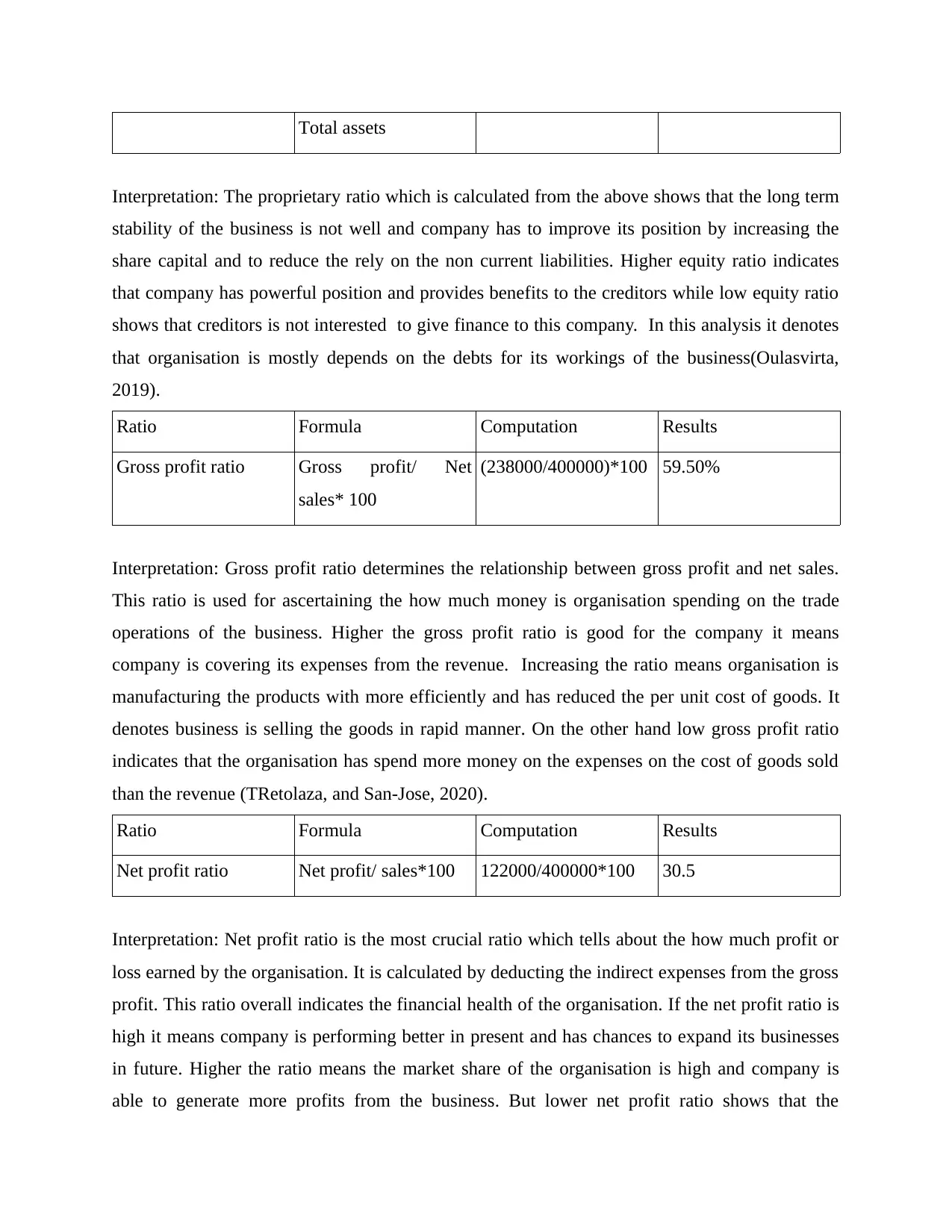
Total assets
Interpretation: The proprietary ratio which is calculated from the above shows that the long term
stability of the business is not well and company has to improve its position by increasing the
share capital and to reduce the rely on the non current liabilities. Higher equity ratio indicates
that company has powerful position and provides benefits to the creditors while low equity ratio
shows that creditors is not interested to give finance to this company. In this analysis it denotes
that organisation is mostly depends on the debts for its workings of the business(Oulasvirta,
2019).
Ratio Formula Computation Results
Gross profit ratio Gross profit/ Net
sales* 100
(238000/400000)*100 59.50%
Interpretation: Gross profit ratio determines the relationship between gross profit and net sales.
This ratio is used for ascertaining the how much money is organisation spending on the trade
operations of the business. Higher the gross profit ratio is good for the company it means
company is covering its expenses from the revenue. Increasing the ratio means organisation is
manufacturing the products with more efficiently and has reduced the per unit cost of goods. It
denotes business is selling the goods in rapid manner. On the other hand low gross profit ratio
indicates that the organisation has spend more money on the expenses on the cost of goods sold
than the revenue (TRetolaza, and San-Jose, 2020).
Ratio Formula Computation Results
Net profit ratio Net profit/ sales*100 122000/400000*100 30.5
Interpretation: Net profit ratio is the most crucial ratio which tells about the how much profit or
loss earned by the organisation. It is calculated by deducting the indirect expenses from the gross
profit. This ratio overall indicates the financial health of the organisation. If the net profit ratio is
high it means company is performing better in present and has chances to expand its businesses
in future. Higher the ratio means the market share of the organisation is high and company is
able to generate more profits from the business. But lower net profit ratio shows that the
Interpretation: The proprietary ratio which is calculated from the above shows that the long term
stability of the business is not well and company has to improve its position by increasing the
share capital and to reduce the rely on the non current liabilities. Higher equity ratio indicates
that company has powerful position and provides benefits to the creditors while low equity ratio
shows that creditors is not interested to give finance to this company. In this analysis it denotes
that organisation is mostly depends on the debts for its workings of the business(Oulasvirta,
2019).
Ratio Formula Computation Results
Gross profit ratio Gross profit/ Net
sales* 100
(238000/400000)*100 59.50%
Interpretation: Gross profit ratio determines the relationship between gross profit and net sales.
This ratio is used for ascertaining the how much money is organisation spending on the trade
operations of the business. Higher the gross profit ratio is good for the company it means
company is covering its expenses from the revenue. Increasing the ratio means organisation is
manufacturing the products with more efficiently and has reduced the per unit cost of goods. It
denotes business is selling the goods in rapid manner. On the other hand low gross profit ratio
indicates that the organisation has spend more money on the expenses on the cost of goods sold
than the revenue (TRetolaza, and San-Jose, 2020).
Ratio Formula Computation Results
Net profit ratio Net profit/ sales*100 122000/400000*100 30.5
Interpretation: Net profit ratio is the most crucial ratio which tells about the how much profit or
loss earned by the organisation. It is calculated by deducting the indirect expenses from the gross
profit. This ratio overall indicates the financial health of the organisation. If the net profit ratio is
high it means company is performing better in present and has chances to expand its businesses
in future. Higher the ratio means the market share of the organisation is high and company is
able to generate more profits from the business. But lower net profit ratio shows that the
Paraphrase This Document
Need a fresh take? Get an instant paraphrase of this document with our AI Paraphraser
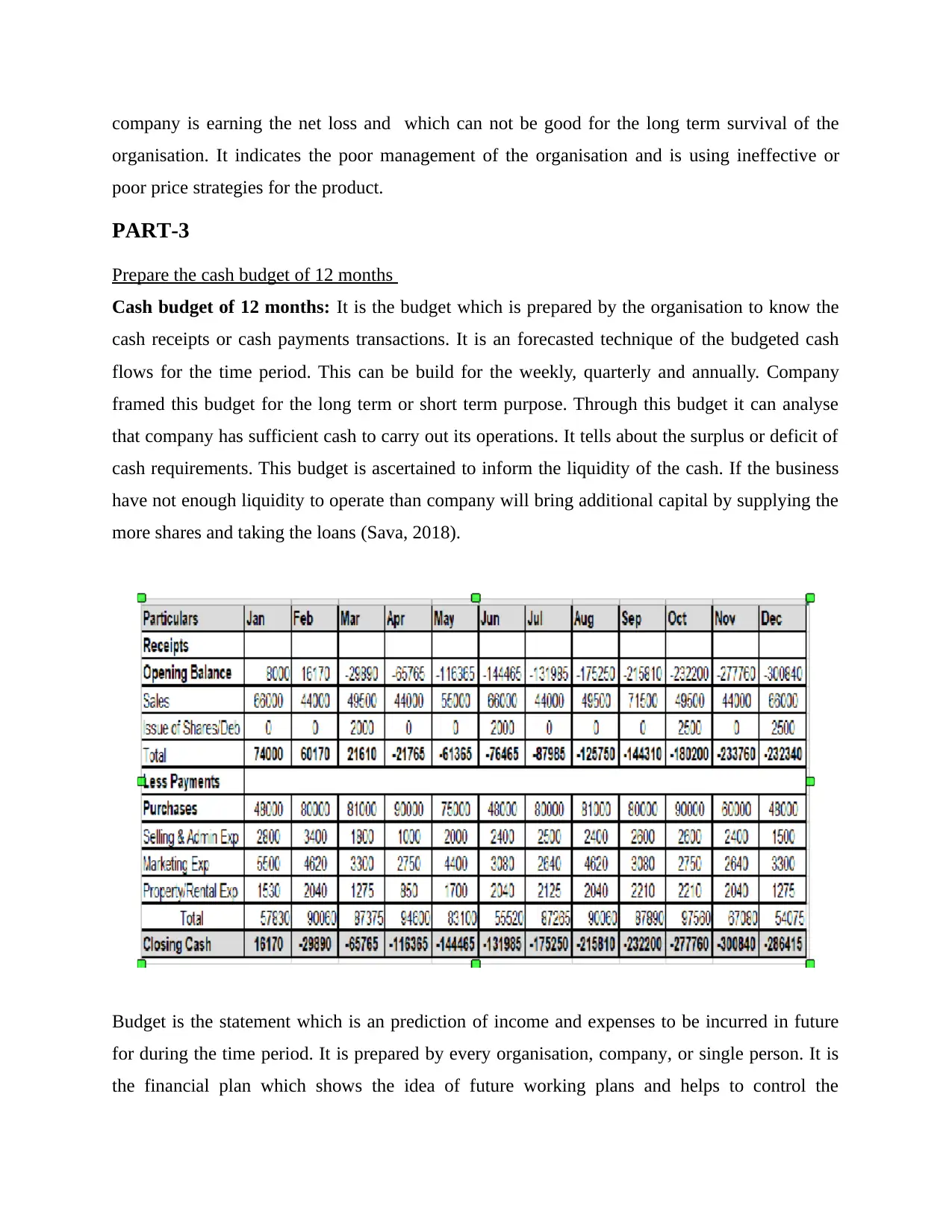
company is earning the net loss and which can not be good for the long term survival of the
organisation. It indicates the poor management of the organisation and is using ineffective or
poor price strategies for the product.
PART-3
Prepare the cash budget of 12 months
Cash budget of 12 months: It is the budget which is prepared by the organisation to know the
cash receipts or cash payments transactions. It is an forecasted technique of the budgeted cash
flows for the time period. This can be build for the weekly, quarterly and annually. Company
framed this budget for the long term or short term purpose. Through this budget it can analyse
that company has sufficient cash to carry out its operations. It tells about the surplus or deficit of
cash requirements. This budget is ascertained to inform the liquidity of the cash. If the business
have not enough liquidity to operate than company will bring additional capital by supplying the
more shares and taking the loans (Sava, 2018).
Budget is the statement which is an prediction of income and expenses to be incurred in future
for during the time period. It is prepared by every organisation, company, or single person. It is
the financial plan which shows the idea of future working plans and helps to control the
organisation. It indicates the poor management of the organisation and is using ineffective or
poor price strategies for the product.
PART-3
Prepare the cash budget of 12 months
Cash budget of 12 months: It is the budget which is prepared by the organisation to know the
cash receipts or cash payments transactions. It is an forecasted technique of the budgeted cash
flows for the time period. This can be build for the weekly, quarterly and annually. Company
framed this budget for the long term or short term purpose. Through this budget it can analyse
that company has sufficient cash to carry out its operations. It tells about the surplus or deficit of
cash requirements. This budget is ascertained to inform the liquidity of the cash. If the business
have not enough liquidity to operate than company will bring additional capital by supplying the
more shares and taking the loans (Sava, 2018).
Budget is the statement which is an prediction of income and expenses to be incurred in future
for during the time period. It is prepared by every organisation, company, or single person. It is
the financial plan which shows the idea of future working plans and helps to control the
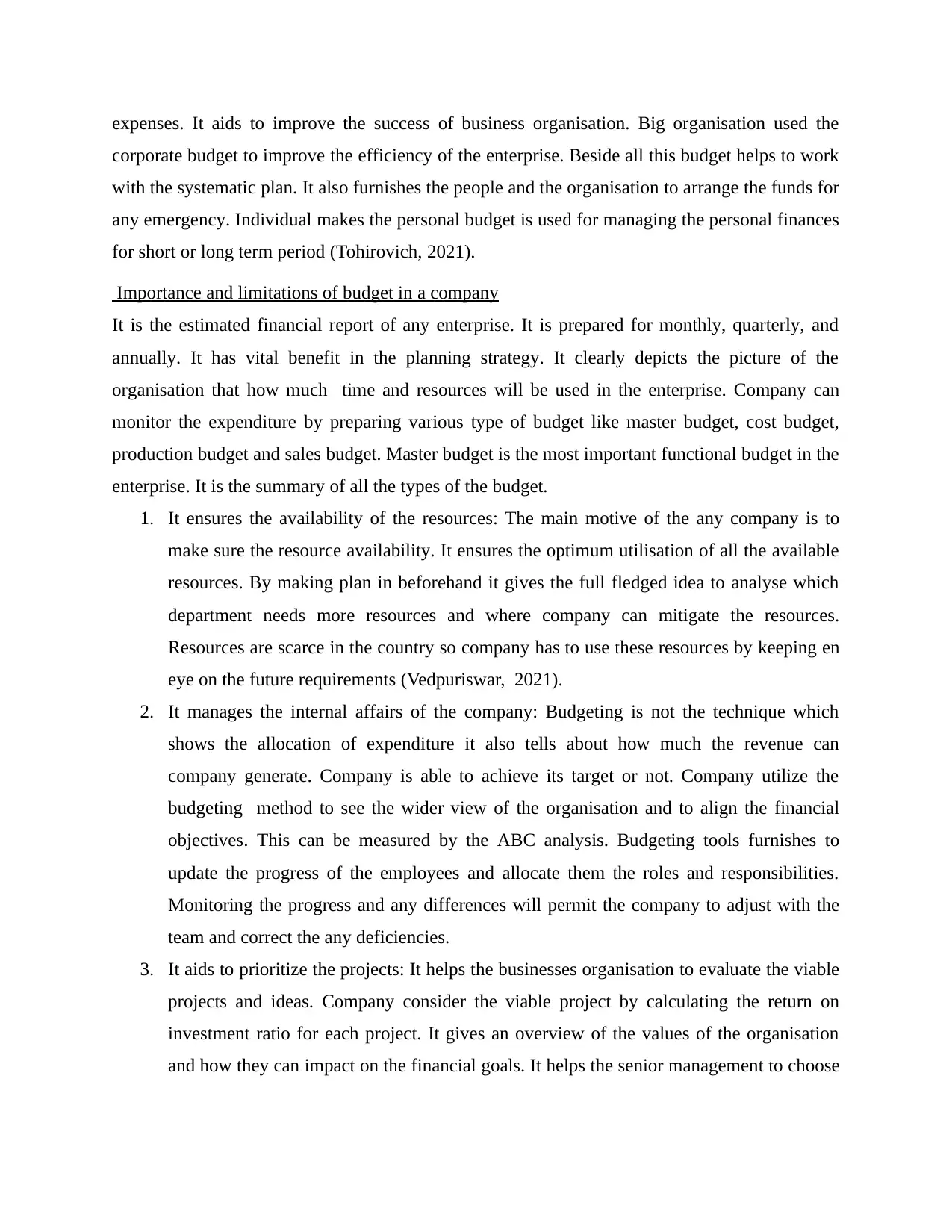
expenses. It aids to improve the success of business organisation. Big organisation used the
corporate budget to improve the efficiency of the enterprise. Beside all this budget helps to work
with the systematic plan. It also furnishes the people and the organisation to arrange the funds for
any emergency. Individual makes the personal budget is used for managing the personal finances
for short or long term period (Tohirovich, 2021).
Importance and limitations of budget in a company
It is the estimated financial report of any enterprise. It is prepared for monthly, quarterly, and
annually. It has vital benefit in the planning strategy. It clearly depicts the picture of the
organisation that how much time and resources will be used in the enterprise. Company can
monitor the expenditure by preparing various type of budget like master budget, cost budget,
production budget and sales budget. Master budget is the most important functional budget in the
enterprise. It is the summary of all the types of the budget.
1. It ensures the availability of the resources: The main motive of the any company is to
make sure the resource availability. It ensures the optimum utilisation of all the available
resources. By making plan in beforehand it gives the full fledged idea to analyse which
department needs more resources and where company can mitigate the resources.
Resources are scarce in the country so company has to use these resources by keeping en
eye on the future requirements (Vedpuriswar, 2021).
2. It manages the internal affairs of the company: Budgeting is not the technique which
shows the allocation of expenditure it also tells about how much the revenue can
company generate. Company is able to achieve its target or not. Company utilize the
budgeting method to see the wider view of the organisation and to align the financial
objectives. This can be measured by the ABC analysis. Budgeting tools furnishes to
update the progress of the employees and allocate them the roles and responsibilities.
Monitoring the progress and any differences will permit the company to adjust with the
team and correct the any deficiencies.
3. It aids to prioritize the projects: It helps the businesses organisation to evaluate the viable
projects and ideas. Company consider the viable project by calculating the return on
investment ratio for each project. It gives an overview of the values of the organisation
and how they can impact on the financial goals. It helps the senior management to choose
corporate budget to improve the efficiency of the enterprise. Beside all this budget helps to work
with the systematic plan. It also furnishes the people and the organisation to arrange the funds for
any emergency. Individual makes the personal budget is used for managing the personal finances
for short or long term period (Tohirovich, 2021).
Importance and limitations of budget in a company
It is the estimated financial report of any enterprise. It is prepared for monthly, quarterly, and
annually. It has vital benefit in the planning strategy. It clearly depicts the picture of the
organisation that how much time and resources will be used in the enterprise. Company can
monitor the expenditure by preparing various type of budget like master budget, cost budget,
production budget and sales budget. Master budget is the most important functional budget in the
enterprise. It is the summary of all the types of the budget.
1. It ensures the availability of the resources: The main motive of the any company is to
make sure the resource availability. It ensures the optimum utilisation of all the available
resources. By making plan in beforehand it gives the full fledged idea to analyse which
department needs more resources and where company can mitigate the resources.
Resources are scarce in the country so company has to use these resources by keeping en
eye on the future requirements (Vedpuriswar, 2021).
2. It manages the internal affairs of the company: Budgeting is not the technique which
shows the allocation of expenditure it also tells about how much the revenue can
company generate. Company is able to achieve its target or not. Company utilize the
budgeting method to see the wider view of the organisation and to align the financial
objectives. This can be measured by the ABC analysis. Budgeting tools furnishes to
update the progress of the employees and allocate them the roles and responsibilities.
Monitoring the progress and any differences will permit the company to adjust with the
team and correct the any deficiencies.
3. It aids to prioritize the projects: It helps the businesses organisation to evaluate the viable
projects and ideas. Company consider the viable project by calculating the return on
investment ratio for each project. It gives an overview of the values of the organisation
and how they can impact on the financial goals. It helps the senior management to choose
⊘ This is a preview!⊘
Do you want full access?
Subscribe today to unlock all pages.

Trusted by 1+ million students worldwide
1 out of 17
Related Documents
Your All-in-One AI-Powered Toolkit for Academic Success.
+13062052269
info@desklib.com
Available 24*7 on WhatsApp / Email
![[object Object]](/_next/static/media/star-bottom.7253800d.svg)
Unlock your academic potential
Copyright © 2020–2025 A2Z Services. All Rights Reserved. Developed and managed by ZUCOL.


